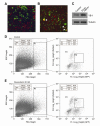p-Glycoprotein ABCB5 and YB-1 expression plays a role in increased heterogeneity of breast cancer cells: correlations with cell fusion and doxorubicin resistance
- PMID: 20649952
- PMCID: PMC2913965
- DOI: 10.1186/1471-2407-10-388
p-Glycoprotein ABCB5 and YB-1 expression plays a role in increased heterogeneity of breast cancer cells: correlations with cell fusion and doxorubicin resistance
Abstract
Background: Cancer cells recurrently develop into acquired resistance to the administered drugs. The iatrogenic mechanisms of induced chemotherapy-resistance remain elusive and the degree of drug resistance did not exclusively correlate with reductions of drug accumulation, suggesting that drug resistance may involve additional mechanisms. Our aim is to define the potential targets, that makes drug-sensitive MCF-7 breast cancer cells turn to drug-resistant, for the anti-cancer drug development against drug resistant breast cancer cells.
Methods: Doxorubicin resistant human breast MCF-7 clones were generated. The doxorubicin-induced cell fusion events were examined. Heterokaryons were identified and sorted by FACS. In the development of doxorubicin resistance, cell-fusion associated genes, from the previous results of microarray, were verified using dot blot array and quantitative RT-PCR. The doxorubicin-induced expression patterns of pro-survival and pro-apoptotic genes were validated.
Results: YB-1 and ABCB5 were up regulated in the doxorubicin treated MCF-7 cells that resulted in certain degree of genomic instability that accompanied by the drug resistance phenotype. Cell fusion increased diversity within the cell population and doxorubicin resistant MCF-7 cells emerged probably through clonal selection. Most of the drug resistant hybrid cells were anchorage independent. But some of the anchorage dependent MCF-7 cells exhibited several unique morphological appearances suggesting minor population of the fused cells maybe de-differentiated and have progenitor cell like characteristics.
Conclusion: Our work provides valuable insight into the drug induced cell fusion event and outcome, and suggests YB-1, GST, ABCB5 and ERK3 could be potential targets for the anti-cancer drug development against drug resistant breast cancer cells. Especially, the ERK-3 serine/threonine kinase is specifically up-regulated in the resistant cells and known to be susceptible to synthetic antagonists.
Figures





References
-
- Jasmin C, Gil-Delgado MA, Marino JP, Ecstein E, Descorps-Declere A, Misset JL. Phase I-II constant infusion of adriamycin (doxorubicin) by ambulatory pump delivery system in heavily pretreated (including adriamycin) breast cancer patients. Ann Oncol. 1990;1:189–193. - PubMed
-
- White SC, Lorigan P, Middleton MR, Anderson H, Valle J, Summers Y, Burt PA, Arance A, Stout R, Thatcher N. Randomized phase II study of cyclophosphamide, doxorubicin, and vincristine compared with single-agent carboplatin in patients with poor prognosis small cell lung carcinoma. Cancer. 2001;92:601–608. doi: 10.1002/1097-0142(20010801)92:3<601::AID-CNCR1360>3.0.CO;2-K. - DOI - PubMed
-
- Clarke R, Dickson RB, Brünner N. The process of malignant progression in human breast cancer. Ann Oncol. 1990;1:401–407. - PubMed
Publication types
MeSH terms
Substances
LinkOut - more resources
Full Text Sources
Medical
Research Materials
Miscellaneous

